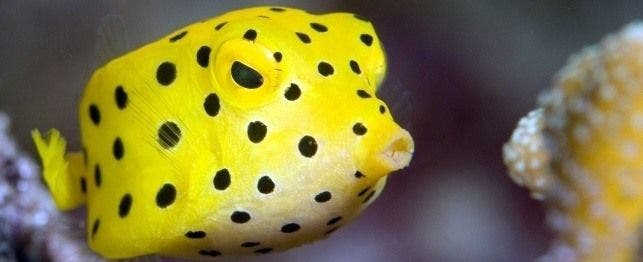
Choosing a Boxfish
For such a small fish, the boxfish (Ostracion spp) is certainly an interesting character. It is unusually constructed, brightly colored, poisonous, and can hover in the water like little aquatic helicopters. Natives to the Indo -Pacific, boxfish, trunkfish and cowfish are all related species belonging to the family of Ostraciidae. These fish have a rigid body made up of bony plates that give them their boxy shape. It is this shape that helps protect them from predation by making boxfish a lot harder to swallow. They have a thin and delicate skin that is sensitive and easily damaged. If frightened or disturbed, they can release a toxin that may kill their tankmates and themselves as well!
Appearance and Behavior
Aquarists keep boxfish primarily for their unusual appearance. The fish appear flat and tapered from the side but a view from the front clearly demonstrates the box-shape. These fish are brightly colored and hard to resist. The blue spotted boxfish sports a top half of black background with white spots while its bottom half is purple with yellow spots. The one kept most frequently by hobbyists is the white spotted boxfish, with a cream colored background and black spots. Boxfish can reach 6 to 18 inches in the wild depending on the species but 4 to 8 inches is more typical in the aquarium given plenty of room. Since boxfish have a rigid body, they are not flexible, so they swim slowly and use their small fins to hover. The challenge in keeping boxfish is the toxin they excrete when frightened or disturbed. The toxin can produce symptoms ranging from disorientation to death, and can be difficult to remove from the water.
Feeding and Tank Requirements
Boxfish are not fussy eaters and worms seem to be a favorite food. Tubifex worms, bloodworms, beef heart and small pieces of fish or brine shrimp are all accepted. Because of their slow swimming habits, they cannot compete with more aggressive eaters that snatch every available morsel. Usual saltwater conditions are adequate to keep boxfish. They will grow to a larger size if given adequate room.
Special Concerns
Since the skin of these fish is delicate, try not to keep cleaner fish in the same tank with boxfish. The attentions of the cleaner fish may irritate or damage the skin. If you will be keeping boxfish with other marine fish, it is often best to make the boxfish the first tank inhabitant, so that it feels secure enough in its environment not to release toxin when exposed to other fish. Make sure you get a bright, well-fleshed fish that demonstrates a good appetite. A thin boxfish that has a sunken appearance is in poor health and will most likely not recover.